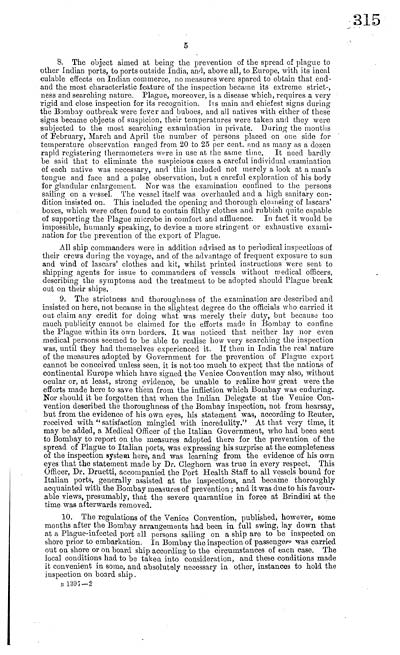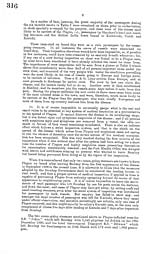Medicine - Disease > Account of plague administration in the Bombay Presidency from September 1896 till May 1897
(329) Page 315
Download files
Individual page:
Thumbnail gallery: Grid view | List view

5
8. The object aimed at being the prevention of the spread of plague to
other Indian ports, to ports outside India, and, above all, to Europe, with its incal
culable effects on Indian commerce, no measures were spared to obtain that end-
and the most characteristic feature of the inspection became its extreme strict-,
ness and searching nature. Plague, moreover, is a disease which, requires a very
rigid and close inspection for its recognition. Its main and chiefest signs during
the Bombay outbreak were fever and buboes, and all natives with either of these
signs became objects of suspicion, their temperatures were taken and they were
subjected to the most searching examination in private. During the months
of February, March and April the number of persons placed on one side for
temperature observation ranged from 20 to 25 per cent. and as many as a dozen
rapid registering thermometers were in use at the same time. It need hardly
be said that to eliminate the suspicious cases a careful individual examination
of each native was necessary, and this included not merely a look at a man's
tongue and face and a pulse observation, but a careful exploration of his body
for glandular enlargement. Nor was the examination confined to the persons
sailing on a vessel. The vessel itself was overhauled and a high sanitary con-
dition insisted on. This included the opening and thorough cleansing of lascars'
boxes, which were often found to contain filthy clothes and rubbish quite capable
of supporting the Plague microbe in comfort and affluence. In fact it would be
impossible, humanly speaking, to device a more stringent or exhaustive exami-
nation for the prevention of the export of Plague.
All ship commanders were in addition advised as to periodical inspections of
their crews during the voyage, and of the advantage of frequent exposure to sun
and wind of lascars' clothes and kit, whilst printed instructions were sent to
shipping agents for issue to commanders of vessels without medical officers,
describing the symptoms and the treatment to be adopted should Plague break
out on their ships.
9. The strictness and thoroughness of the examination are described and
insisted on here, not because in the slightest degree do the officials who carried it
out claim any credit for doing what was merely their duty, but because too
much publicity cannot be claimed for the efforts made in Bombay to confine
the Plague within its own borders. It was noticed that neither lay nor even
medical persons seemed to be able to realise how very searching the inspection
was, until they had themselves experienced it. If then in India the real nature
of the measures adopted by Government for the prevention of Plague export
cannot be conceived unless seen, it is not too much to expect that the nations of
continental Europe which have signed the Venice Convention may also, without
ocular or, at least, strong evidence, be unable to realize how great were the
efforts made here to save them from the infliction which Bombay was enduring.
Nor should it be forgotten that when the Indian Delegate at the Venice Con-
vention described the thoroughness of the Bombay inspection, not from hearsay,
but from the evidence of his own eyes, his statement was, according to Reuter,
received with "satisfaction mingled with incredulity." At that very time, it
may be added, a Medical Officer of the Italian Government, who had been sent
to Bombay to report on the measures adopted there for the prevention of the
spread of Plague to Italian ports, was expressing his surprise at the completeness
of the inspection system here, and was learning from the evidence of his own
eyes that the statement made by Dr. Cleghorn was true in every respect. This
Officer, Dr. Druetti, accompanied the Port Health Staff to all vessels bound for
Italian ports, generally assisted at the inspections, and became thoroughly
acquainted with the Bombay measures of prevention; and it was due to his favour-
able views, presumably, that the severe quarantine in force at Brindisi at the
time was afterwards removed.
10. The regulations of the Venice Convention, published, however, some
months after the Bombay arrangements had been in full swing, lay down that
at a Plague-infected port all persons sailing on a ship are to be inspected on
shore prior to embarkation. In Bombay the inspection of passengers was carried
out on shore or on board ship according to the circumstances of each case. The
local conditions had to be taken into consideration, and these conditions made
it convenient in some, and absolutely necessary in other, instances to hold the
inspection on board ship.
B 1397-2
8. The object aimed at being the prevention of the spread of plague to
other Indian ports, to ports outside India, and, above all, to Europe, with its incal
culable effects on Indian commerce, no measures were spared to obtain that end-
and the most characteristic feature of the inspection became its extreme strict-,
ness and searching nature. Plague, moreover, is a disease which, requires a very
rigid and close inspection for its recognition. Its main and chiefest signs during
the Bombay outbreak were fever and buboes, and all natives with either of these
signs became objects of suspicion, their temperatures were taken and they were
subjected to the most searching examination in private. During the months
of February, March and April the number of persons placed on one side for
temperature observation ranged from 20 to 25 per cent. and as many as a dozen
rapid registering thermometers were in use at the same time. It need hardly
be said that to eliminate the suspicious cases a careful individual examination
of each native was necessary, and this included not merely a look at a man's
tongue and face and a pulse observation, but a careful exploration of his body
for glandular enlargement. Nor was the examination confined to the persons
sailing on a vessel. The vessel itself was overhauled and a high sanitary con-
dition insisted on. This included the opening and thorough cleansing of lascars'
boxes, which were often found to contain filthy clothes and rubbish quite capable
of supporting the Plague microbe in comfort and affluence. In fact it would be
impossible, humanly speaking, to device a more stringent or exhaustive exami-
nation for the prevention of the export of Plague.
All ship commanders were in addition advised as to periodical inspections of
their crews during the voyage, and of the advantage of frequent exposure to sun
and wind of lascars' clothes and kit, whilst printed instructions were sent to
shipping agents for issue to commanders of vessels without medical officers,
describing the symptoms and the treatment to be adopted should Plague break
out on their ships.
9. The strictness and thoroughness of the examination are described and
insisted on here, not because in the slightest degree do the officials who carried it
out claim any credit for doing what was merely their duty, but because too
much publicity cannot be claimed for the efforts made in Bombay to confine
the Plague within its own borders. It was noticed that neither lay nor even
medical persons seemed to be able to realise how very searching the inspection
was, until they had themselves experienced it. If then in India the real nature
of the measures adopted by Government for the prevention of Plague export
cannot be conceived unless seen, it is not too much to expect that the nations of
continental Europe which have signed the Venice Convention may also, without
ocular or, at least, strong evidence, be unable to realize how great were the
efforts made here to save them from the infliction which Bombay was enduring.
Nor should it be forgotten that when the Indian Delegate at the Venice Con-
vention described the thoroughness of the Bombay inspection, not from hearsay,
but from the evidence of his own eyes, his statement was, according to Reuter,
received with "satisfaction mingled with incredulity." At that very time, it
may be added, a Medical Officer of the Italian Government, who had been sent
to Bombay to report on the measures adopted there for the prevention of the
spread of Plague to Italian ports, was expressing his surprise at the completeness
of the inspection system here, and was learning from the evidence of his own
eyes that the statement made by Dr. Cleghorn was true in every respect. This
Officer, Dr. Druetti, accompanied the Port Health Staff to all vessels bound for
Italian ports, generally assisted at the inspections, and became thoroughly
acquainted with the Bombay measures of prevention; and it was due to his favour-
able views, presumably, that the severe quarantine in force at Brindisi at the
time was afterwards removed.
10. The regulations of the Venice Convention, published, however, some
months after the Bombay arrangements had been in full swing, lay down that
at a Plague-infected port all persons sailing on a ship are to be inspected on
shore prior to embarkation. In Bombay the inspection of passengers was carried
out on shore or on board ship according to the circumstances of each case. The
local conditions had to be taken into consideration, and these conditions made
it convenient in some, and absolutely necessary in other, instances to hold the
inspection on board ship.
B 1397-2
Set display mode to: Large image | Zoom image | Transcription
Images and transcriptions on this page, including medium image downloads, may be used under the Creative Commons Attribution 4.0 International Licence unless otherwise stated. ![]()
| India Papers > Medicine - Disease > Account of plague administration in the Bombay Presidency from September 1896 till May 1897 > (329) Page 315 |
|---|
| Permanent URL | https://digital.nls.uk/74517668 |
|---|




